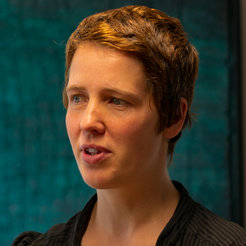“By the end of May, we could reach well below 1000 new infections per day”
Viola Priesemann from the Max Planck Institute for Dynamics and Self-Organization talks about the spread of the coronavirus Sars-CoV-2 and strategies to contain the Covid-19 epidemic. She is one of the authors of a statement by non-university research organisations on pandemic.
Germany is looking for a way out of the Covid-19 epidemic. The Fraunhofer-Gesellschaft, the Helmholtz Association, the Leibniz Association, and the Max-Planck-Gesellschaft have jointly published a statement outlining various paths through the corona epidemic based on model calculations. Viola Priesemann, who heads a research group at the Max Planck Institute for Dynamics and Self-Organization, is co-author of this position paper. Her team has calculated two scenarios of how the coronavirus will spread in the coming weeks. We talked to her about different strategies for overcoming the epidemic as well as the possible consequences of a renewed increase in new infections and how this could be averted.

Dr Priesemann, when can the restrictions set in place to contain the corona epidemic be relaxed?
Many people want the restrictions to be relaxed – but that would mean accepting that the infection rate and the number of new infections would rise again. We would probably have to make drastic restrictions again in a few weeks in order to dampen the second wave. So we would be right back where we were in mid-March. We therefore advocate taking advantage of the great opportunity we have at the moment. The number of new infections is lower than it has been for a long time. If we can reduce it to only a few hundred confirmed cases per day, we can trace the chains of infection and isolate the contacts of positively tested patients. The more we suppress infections, the faster we arrive at several hundred cases. We can then allow ourselves more freedom again.
How long will it take until the number of new infections per day drops to well below 1000 cases?
Thanks to the contact ban, we have reached a state in which the number of daily new infections has decreased quite rapidly. Instead of over 6,000 new infections, we are now at 1,000 to 2,000. In the last few weeks, the effective reproduction rate was significantly below 1. If things remain this way, we could reach a few hundred cases per day by the end of May.
Is it also possible to manage the epidemic if there are more new infections every day?
In principle, there are only two natural ends of an epidemic: either the virus will be eradicated or enough people will become immune. However, relying on some form of general immunity entails some risks. We still don’t know how long a person remains immune after a corona infection. And long-term immunity is necessary in order to decrease the spread. With these uncertainties about immunity, further spread is very risky. We also know very little about the possible after-effects of COVID-19.
But in Germany, hospitals been able to properly care for patients with severe Covid-19. And some have even announced reduced working hours…
This is only because the hospitals are working in a state of emergency and have postponed all elective operations in order to ensure enough beds in intensive care. Hospitals have stated that with normal operation in Germany, there would be considerably fewer intensive care beds available to care for additional COVID-19 patients. Suspected cases of COVID-19 must also be treated in isolation as a precaution. It is also essential that in the medium term, all non-COVID patients can return to the same condition as before the epidemic. It is not clear how many beds can be made available for COVID-19 patients without sacrificing some of the care provided for others.
So are the measures to contain the corona epidemic being eased prematurely?
In principle, restrictions can be relaxed if this does not lead to additional infections. Unfortunately, we don’t know what risks are involved with each individual relaxation. To gain insight into this, we should proceed carefully and gradually. If we relax all restrictions at once, we risk another wave of infection. It will also take two to three weeks before we see the effects of relaxation. In this time, there can be a considerable spread without us noticing it. We would thus risk gambling away the successes of the efforts made in recent weeks. We must therefore relax measures individually and in a targeted manner and closely observe how the relaxation affects new infections two to three weeks later. However, which measures should first be relaxed must be decided upon in an open discourse that includes all socially important aspects such as economic, social, and psychological effects.
One has the impression that there are always new goals in the containment of the epidemic. What do you think the goal must be?
When the number of infections was increasing exponentially, the short-term goal was clearly to stop the exponential spread. This has been achieved with great commitment. The daily number of new infections has clearly decreased since the beginning of April. At first glance, it appears that we have reached our goal. But that’s not the case. When deciding on a goal, we must realize that the virus will not simply disappear. We will likely be still dealing with it in the coming months or years. We therefore need a strategy that is viable in the long term. The only sustainable solution we see is to contain the virus as much as possible so that the remaining chains of infection can be traced and that possible new sources of infection can be identified as quickly as possible.
Interview: Peter Hergersberg
